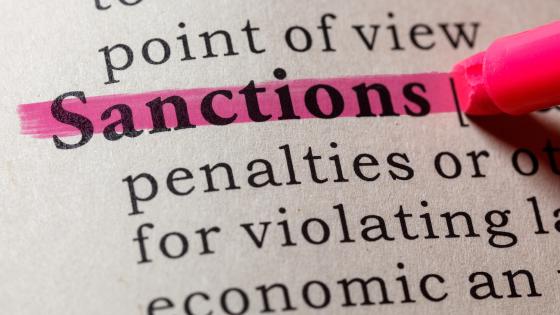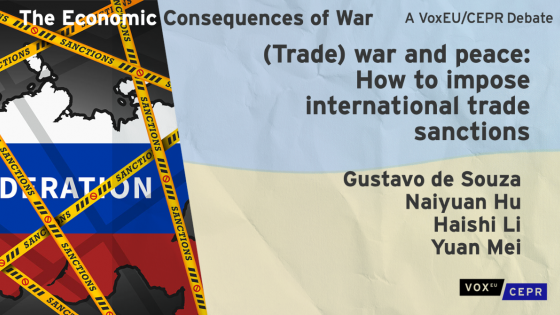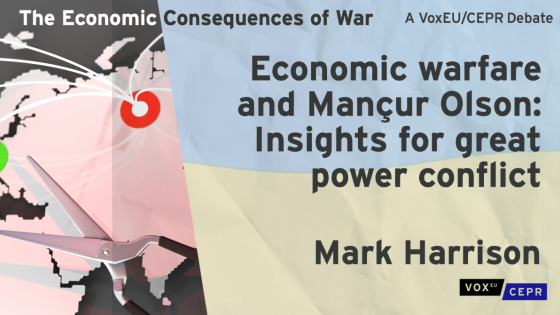What may sanctions be expected to achieve? This question is currently fraught for two reasons. One is the proliferation of sanctions since Russia launched a full-scale war against Ukraine in 2022. With 13,000 sanctions in place against Russia alone (Atlantic Council 2023), sanctions and countersanctions are now everywhere.
Another reason is that the war continues and shows no sign of coming to an end. There is uncertainty over whether sanctions might have avoided the war, whether they can now sufficiently punish Russia for its aggression, or if they can contribute to Russia’s defeat. While some have drawn attention to the costs to the West of imposing sanctions (Hinz and Crozet 2016, Schropp et al. 2022, Mei et al. 2022) and the scope for Russia to mitigate or even shrug off the consequences (Oegg and Elliott 2008, Nigmatulina 2022, Cecchetti and Berner 2022), others have argued that Western sanctions were becoming increasingly effective (Bergelijk 2012) and may now have severe consequences for Russia (Ongena 2022, Simola 2022).
Recent historical writing has noted that present-day sanctions have their origins in economic warfare in the two World Wars, reflected in the setup of the interwar League of Nations and postwar United Nations (Dehne 2019, Mulder 2022). In a recent paper (Harrison 2023), I review that experience, asking what economic warfare was expected to achieve and whether these expectations were matched by results.
To begin, two clarifications are useful. One is that the purposes of economic warfare then were narrower than those of sanctions now. According to Giumelli (2011), sanctions aim to constrain, coerce, or signal. In the two World Wars, economic warfare had one purpose: to weaken the adversary’s fighting power by constraining the supply of war (Vickers 1943). It was not expected to signal or incentivise any course of action except surrender. Thus economic warfare concerns ‘constraining’ sanctions, which are a relatively small subset of today’s sanctions.
The other thing is that the experience considered by the literature is much narrower than it should be. Most of it is the experience of Germany in two World Wars. For that reason, Stephen Broadberry and I are currently engaged in a parallel project to bring together research on economic warfare from a wider sample of periods and conflicts.
Lesson 1. Modern economies were tough targets
Both wars saw horrifying attrition on the battlefield. Leaders on each side looked for ways to win a quick victory and stop the slaughter. At the start of the 20th century, as the world became increasingly globalised and interdependent, influential observers (Angel 1912, Bloch 1899) argued that modern industrial economies were vulnerable to naval blockade. They thought a blockade could stop essential imports of food and materials, causing unemployment, famine, and collapse. They imagined the threat of blockade as powerful enough to prevent war.
This view became popular (and has never gone away). However, two World Wars proved it to be wishful thinking. While global trade was thoroughly disrupted, and civilian welfare declined, both wars saw sustained economic mobilisation on both sides. Contrary to Bloch’s expectation, it was the less modernised, more agrarian economies that saw the worst food shortages. Countries that dropped out early did so because they were defeated on the battlefield, not because their economies collapsed.
Those who expected the supply of war to collapse in the face of a sudden trade shock had the wrong model of economic interdependence. They imagined it as a chain of fragile links: disruption at any point would cause the entire chain to fail. In fact, the modern economy was a resilient network. Firms and households could adjust to sudden shortages by economising and substitution. As a result, no shock to supply had the catastrophic effect that seemed likely at first sight.
Lesson 2. Economic warfare took time
In the two World Wars, it was anticipated that economic action would be fast – implicitly, fast enough to deter or pre-empt military action. In the outcome, the pace of economic action was frustratingly slow. The first reason was that action against the adversary’s economy turned civilian property and lives into targets. This flew in the face of international norms that protected civilian interests and the rights of neutral countries to trade with both sides. To erode the leaders’ scruples and fears took time.
This was not the only obstacle. Another constraint was the available means. In WWI, Germany took nearly three years to build its fleet of operational submarines. Almost half of all Allied and neutral shipping losses were inflicted as late as 1917. WWII was widely expected to begin with devastating air attacks on cities, but the blows traded in the war’s first three years were puny by comparison with what was to come. Three-quarters of Allied bombs on Germany’s economic targets fell in the war’s last year. Thus, economic warfare was slow to unfold.
Finally, the impact of economic warfare was delayed by the adversary’s adaptation. Trade could be diverted through neutral neighbours. The war effort could be protected by cutting back on less-pressing civilian uses of fuel, textiles, and metal goods. Substitutes could be found for many foods and materials previously thought of as irreplaceable.
Faced with sudden shortages, both producers and consumers made extraordinary efforts to make do with less. No commodity was truly essential at the margin (Olson 1963, Harrison 2022). As a result, the immediate effect on fighting power of any attack on supply was always less than anticipated, and often zero.
Lesson 3. Economic warfare was powerful – eventually
When attacking the economy had no immediate effects on the battlefield, bored observers and analysts tended to withdraw attention, concluding that there was nothing to see. After 1940, Hitler decided to scale down Germany’s air attack on Britain’s cities on these grounds (Overy 1977: 47). Like others, he lost sight of a key point: economic warfare took time and required patience. Its effects were slow but cumulative. Eventually, adaptation encountered limits. Once the limits were reached, economic warfare sped up and became fast.
The limits were found in the civilian sphere. The goal of economic warfare was to deny resources to the adversary’s war effort. The adversary’s countermove was to protect the war effort by shifting the costs of adaptation onto civilians. In the short run, as a result, it was civilian resources and reserves that were gradually depleted by economic warfare. Somewhere there was a constraint on civilian cooperation. When the constraint was reached, the damage done by economic warfare would rebound into the war effort.
In the case of Germany, both World Wars gradually depleted civilian resources by restricting consumption and nutrition. WWI saw many hunger deaths. In WWII, Germany fed itself at the expense of the occupied territories, but there were still food shortages and, from 1944, signs of raised mortality.
For WWII there are numerous estimates of the effects of bombing on German war production and fighting power (US Strategic Bombing Survey 1945, British Bombing Survey Unit 1998; see also Overy 1983, Tooze 2006). Many are self-serving and few are well identified. The most evidence-led estimates were made by the British Bombing Survey Unit (1998); they relied on a mix of direct calculations and differences in differences. While sample sizes were small and robustness tests lacking, they suggested that the period in which German war production was fully protected from the effects of relatively light bombing lasted through the second quarter of 1943. From mid-1943, protection became partial (heavier bombing began to depress total output, while war production fell by less). The final collapse of war production was brought about by an overwhelming air campaign against German transportation from the third quarter of 1944.
Lesson 4. The threat of economic warfare was also powerful
If economic warfare proved to be powerful ex post, then it should also be powerful ex ante. Embedded in the League of Nations was the belief that a credible threat of blockade could deter aggression (Dehne 2019, Mulder 2022). Recall that sanctions can constrain (as in economic warfare), coerce, or signal. A threat does not constrain; it coerces and/or signals.
How did that work out? In the interwar period, the threat of blockade worked to deter smaller powers from making war on their neighbours. The story of the great powers is different (Mulder 2022). The expectation of blockade did not deter Germany from starting WWI, or Germany, Italy, or Japan from starting WWII.
The Axis Powers did not neglect the likelihood of blockade. Rather, they directed and timed their aggression to pre-empt it. They planned to conquer territories that would guarantee the war supplies they needed, leaving them self-sufficient. Thus, the threat of economic warfare became an accelerant of aggression, not a deterrent.
If the threat of sanctions was a powerful signal, the problem was that the signal received was not the signal sent. The signal sent was: “Economically we are strong, and you are weak. Comply, or we will starve you.” The signal received was: “Our enemies are strong economically but weak militarily. Strike them now.”
Conclusion
In both World Wars, economic warfare was at centre stage, not on the sidelines. It helped to decide what battles were fought and who would win them.
In both wars, economic warfare was unavoidable. It was a phase of attrition (O’Brien 2015), not an alternative to it. In wartime, economic and military actions were complements, not substitutes. In peacetime, without war readiness, attempts to constrain the adversary by economic sanctions invited violent escalation.
This is not an argument against sanctions. In peacetime, constraining sanctions cannot be relied on to act alone; they must be combined with deterrence. In wartime, economic warfare does not win battles, but it helps to decide who will win them when they are fought.
References
Atlantic Council (2023), "Russia sanctions database", website.
British Bombing Survey Unit (1998), The strategic air war against Germany, 1939–1945, London: Frank Cass.
Bergelijk, P (2012), “Failure and success of economic sanctions”, VoxEU.org, 27 March.
Bloch, I (1899), Is war now impossible?, London: Grant Richards.
Cecchetti, S, and R Berner (2022), “Russian sanctions: Some questions and answers”, VoxEU.org, 21 March.
Dehne, P (2019), After the Great War: Economic warfare and the promise of peace in Paris 1919, London: Bloomsbury.
Giumelli, F (2011), Coercing, constraining and signalling: Explaining UN and EU sanctions after the Cold War, Colchester: ECPR Press.
Harrison, M (2022), “Economic warfare and Mançur Olson: Insights for great power conflict”, VoxEU.org, 25 March.
Harrison, M (2023), “Economic warfare: Lessons from two world wars”, CEPR Discussion Paper18439.
Hinz, J, and M Crozet (2016), “Collateral damage: The impact of the Russia sanctions on sanctioning countries’ exports”, VoxEU.org, 5 July.
Mei, Y, N Li, and G de Souza (2022), “(Trade) war and peace: How to impose international trade sanctions”, VoxEU.org, 5 September.
Mulder, N (2022), The economic weapon: The rise of sanctions as a tool of modern war, New Haven: Yale University Press.
Nigmatulina, D (2022), “How US sanctions increased the economic activity of sanctioned Russian firms”, VoxEU.org, 19 November.
O’Brien, P (2015), How the war was won: Air-sea power and Allied victory in World War II, Cambridge: Cambridge University Press.
Oegg, B, and K Elliott (2008), “Russia and the effectiveness of economic sanctions between big players”, VoxEU.org, 8 October.
Olson, M (1963), The economics of the wartime shortage: A history of British food supplies in the Napoleonic War and in World Wars I and II, Durham, NC: Duke University Press.
Ongena, S, A Pestova, and M Mamonov (2022), “The price of war: Macroeconomic effects of the 2022 sanctions on Russia”, VoxEU.org, 15 April.
Overy, R (2003), The air war, 1939–1945, Kindle edition.
Schropp, S, C Lau, K Mahlstein, and O Latipov (2022), “The economic effects of potential EU tariff sanctions on Russia”, VoxEU.org, 30 September.
Simola, H (2022), “War and sanctions: Effects on the Russian economy”, VoxEU.org, 15 December.
Tooze, A (2006), The wages of destruction: The making and the breaking of the Nazi economy, London: Allen Lane.
US Strategic Bombing Survey (1945), The effects of strategic bombing on the German war economy, Overall Economic Effects Division, Washington DC.
Vickers, C G (1943), “Economic warfare”, RUSI Journal 88(549): 14–22.



